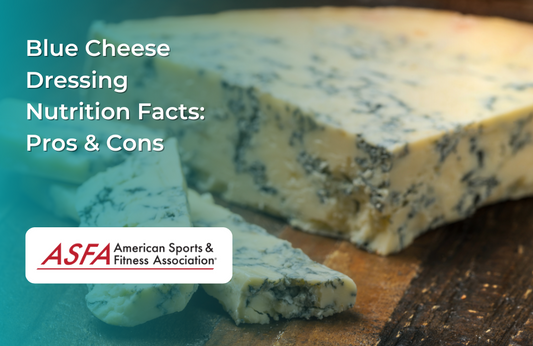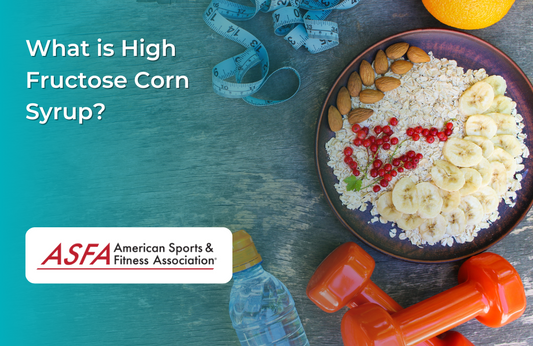Fructose is a naturally occurring sugar that is widely consumed in various forms, ranging from fresh fruits and vegetables to processed sweeteners like high-fructose corn syrup (HFCS). Known for its intense sweetness, dietary fructose plays a significant role in energy metabolism, primarily in the liver, and has become the subject of much debate due to its impact on metabolism and health. In this comprehensive blog post, we will delve deep into fructose’s characteristics, its metabolic pathway, its role in the body, and the implications of excessive consumption, with insights based on the expertise of the American Sports and Fitness Association (ASFA). We will also explore how fructose influences carbohydrate metabolism and its interactions with glucose, highlighting the potential health consequences such as metabolic syndrome and energy availability.
What is Fructose?
Fructose, also known as fruit sugar, is a type of monosaccharide, or simple sugar, meaning it is composed of a single sugar molecule. This distinguishes it from more complex carbohydrates, such as disaccharides (which are made of two monosaccharides) and polysaccharides (long chains of sugar molecules). Fructose exists in both a linear and ring form, depending on its environment.
Although fructose is chemically similar to glucose, another simple sugar, its molecular structure differs slightly, giving fructose its distinct metabolic pathway. Fructose occurs naturally in:
-
Fruits such as apples, pears, grapes, and berries
-
Vegetables like carrots, onions, and sweet potatoes
-
Honey
-
Certain sweeteners, including sucrose (table sugar) and high-fructose corn syrup
Fructose is often used as a sweetening agent in food products due to its intensely sweet flavor, making it a popular choice in both natural and processed forms.
Sources of Fructose
Fructose is a naturally occurring sugar found in a variety of sources, both natural and commercial. Naturally, fructose is abundant in fruits, vegetables, honey, and some grains. These sources provide fructose along with essential nutrients, fiber, and water, which help mitigate its effects on the body.
Commercially, fructose is produced from sugar cane, sugar beets, and maize. One of the most common commercial forms is high-fructose corn syrup (HFCS), a liquid sweetener derived from corn starch. HFCS is widely used in processed foods and beverages, including sweetened drinks, baked goods, and canned goods, due to its low cost and high sweetness. Table sugar, or sucrose, is another prevalent source of fructose. Sucrose is composed of equal parts glucose and fructose and is commonly used in a variety of food products.
The widespread use of HFCS and table sugar in processed foods has raised concerns about the health impacts of excessive fructose consumption, particularly in the context of modern diets that are high in added sugars.
Fructose and High Fructose Corn Syrup in Processed Foods
Beyond its natural sources, fructose is a key component of sucrose (table sugar) and high-fructose corn syrup (HFCS). Sucrose is a disaccharide made up of one molecule of glucose and one molecule of fructose. HFCS, widely used in processed foods and beverages, contains varying amounts of fructose (usually between 42% and 55%), with the remainder being glucose. HFCS is prevalent in sodas, fruit juices, snack foods, and desserts, largely due to its low cost and sweetness.
Despite the rise in HFCS consumption, the overall ratio of fructose to glucose intake has remained stable compared to traditional sweeteners like sucrose. The use of HFCS in the food industry has sparked concerns about excessive fructose consumption and its effects on health, particularly in the context of the modern diet, which includes significant amounts of added sugars.
Fructose Metabolism: A Unique Pathway
Fructose metabolism is markedly different from glucose metabolism, largely because fructose is processed almost exclusively in the liver. Here's a step-by-step breakdown of how fructose is metabolized:
-
Absorption in the Small Intestine: After ingestion, fructose is absorbed in the small intestine and transported to the liver via the portal vein. Unlike glucose, which is metabolized by nearly every cell in the body, fructose is primarily metabolized in the liver.
-
Fructose Breakdown in the Liver: Once in the liver, fructose undergoes phosphorylation by the enzyme fructokinase, which converts it into fructose-1-phosphate. From here, fructose can be metabolized into several compounds, including glucose, glycogen (the body's stored form of glucose), lactate, and fatty acids.
-
Conversion to Glucose and Glycogen: In small amounts, fructose is converted into glucose or glycogen, which can be used by the body for energy or stored in the liver and muscles for later use.
-
Lipogenesis (Fat Formation): When consumed in excess, fructose can contribute to lipogenesis, the process of creating fatty acids and triglycerides. This is because once glycogen stores are full, any extra fructose is converted into fat, which may accumulate in the liver and bloodstream. Over time, this can lead to conditions such as non-alcoholic fatty liver disease (NAFLD) and increased risk of cardiovascular disease.
-
No Insulin Response: Unlike glucose, fructose does not cause a significant release of insulin. While this might seem like a benefit at first glance, it also means that fructose bypasses the body's usual mechanisms for regulating hunger and satiety, such as the hormone leptin. As a result, fructose consumption may not provide the same sense of fullness as glucose, potentially leading to overeating.
Chemical and Physical Properties
Fructose is a ketonic simple sugar with the chemical formula C6H12O6. It has a molecular weight of 180.16 g/mol and a melting point of 103-105°C. One of the most notable characteristics of fructose is its high solubility in water, which contributes to its intense sweetness. In fact, fructose is approximately 1.2 to 1.8 times sweeter than sucrose (table sugar), making it a popular choice in food manufacturing.
Fructose is also hygroscopic, meaning it can absorb moisture from the air. This property makes it useful as a humectant in food products, helping to maintain moisture and extend shelf life. Additionally, fructose can exist in different forms, including crystalline fructose, which is a white, odorless, and sweet solid. Crystalline fructose is often used in food products where a high level of sweetness is desired without adding significant bulk.
Fructose and Sweetness
One of the defining characteristics of fructose is its intense sweetness. Fructose is approximately 1.2 to 1.8 times sweeter than sucrose (table sugar), which is why it is widely used in food manufacturing. Its potent sweetness allows manufacturers to use less sugar while still achieving the desired flavor, making it a cost-effective ingredient in processed foods.
However, this heightened sweetness can have unintended consequences. Foods and beverages containing fructose, especially in high concentrations, can contribute to sugar cravings and overeating, as fructose stimulates the brain's reward system more intensely than other sugars. This, in turn, may increase the risk of weight gain and associated metabolic disorders.
Fructose and Nutrition
In its natural form, fructose found in whole fruits and vegetables provides important nutritional benefits. Whole fruits, for example, contain fiber, vitamins, minerals, and antioxidants that contribute to overall health. The dietary fiber in fruits slows the absorption of fructose, preventing the rapid spikes in blood sugar and insulin that are often associated with refined sugars. Moreover, the water content in fruits helps regulate fructose metabolism, reducing its negative impact on the body.
However, some individuals suffer from fructose intolerance, where they cannot properly absorb fructose. This condition, especially in cases of hereditary fructose intolerance (HFI), necessitates strict dietary modifications to avoid severe health complications following fructose or sucrose consumption.
When consumed as part of a balanced diet, fructose from natural sources plays a healthy role in nutrition by:
-
Providing energy: Fructose can be used by the body for immediate energy, particularly in active individuals.
-
Supporting hydration: Fruits, which are rich in water, help maintain hydration while delivering nutrients.
-
Offering protective compounds: Whole fruits contain antioxidants, which combat oxidative stress and inflammation in the body.
However, the potential risks associated with fructose arise primarily when it is consumed in excessive amounts from added sugars in processed foods. High intake of added fructose has been linked to a range of health issues, including:
-
Obesity: Fructose’s conversion to fat in the liver, coupled with its lack of impact on satiety hormones, makes it a key player in weight gain and increased body fat, particularly visceral fat (fat stored around the organs).
-
Type 2 Diabetes: Overconsumption of fructose can impair insulin sensitivity, increasing the risk of insulin resistance and type 2 diabetes over time.
-
Metabolic Syndrome: High levels of added fructose consumption are associated with metabolic syndrome, a cluster of conditions including high blood pressure, abnormal cholesterol levels, and increased abdominal fat.
-
Cardiovascular Disease: Excess fructose promotes the production of triglycerides and increases LDL (bad) cholesterol, contributing to heart disease.
-
Non-Alcoholic Fatty Liver Disease (NAFLD): The liver’s overproduction of fat from excess fructose intake can lead to fat buildup in the liver, which over time can progress to NAFLD, a condition linked to liver dysfunction and other health complications.
Naturally Occurring Fructose vs. Added Fructose
It's essential to distinguish between the fructose found naturally in whole fruits and vegetables and the fructose added to processed foods. Naturally occurring fructose comes with fiber, water, and other beneficial compounds that help mitigate the sugar's effects on metabolism. In contrast, the added fructose found in soft drinks, candies, and packaged snacks lacks these protective elements and can contribute to health problems when consumed in excess.
Research indicates that the negative effects of fructose are primarily linked to added sugars rather than the fructose in whole fruits. For example, eating an apple not only delivers fructose but also provides fiber, antioxidants, and water, which slow down digestion and improve satiety. On the other hand, consuming a soda that contains high levels of HFCS provides fructose in a concentrated form, without any of the beneficial nutrients that whole fruits offer.
Cellular and Molecular Level
At the cellular and molecular level, fructose metabolism is distinct from that of glucose. After ingestion, fructose is absorbed by the gut and transported to the liver, where it undergoes a series of metabolic processes. The liver plays a central role in metabolizing fructose, converting it into glucose, glycogen, or fat.
The metabolism of fructose involves several key enzymes, including fructokinase, aldolase B, and triosephosphate isomerase. Fructose uptake in the liver is facilitated by the GLUT5 transporter, which has a high affinity for fructose. Once inside the liver, fructose is phosphorylated by fructokinase to form fructose-1-phosphate, which is then broken down into intermediates that can enter various metabolic pathways.
The presence of glucose can influence fructose metabolism, as glucose can enhance the uptake and metabolism of fructose. However, excessive fructose consumption can overwhelm the liver’s capacity to metabolize it, leading to the production of fat and contributing to metabolic syndrome. This cluster of conditions, which includes high blood pressure, abnormal cholesterol levels, and increased abdominal fat, increases the risk of developing type 2 diabetes and cardiovascular disease.
By understanding the unique metabolic pathway of fructose and its implications for health, we can make more informed dietary choices to support overall well-being.
Balancing Fructose Intake: Tips
To ensure that fructose intake supports health rather than detracts from it, it’s important to focus on moderation and choose whole foods over processed ones. Here are some actionable tips to help balance fructose consumption:
-
Prioritize Whole Fruits: Whole fruits are a valuable source of naturally occurring fructose, fiber, and essential nutrients. Including a variety of fruits in your diet supports overall health while delivering fructose in a balanced, nutrient-dense package.
-
Limit Added Sugars: Be mindful of foods and beverages that contain high levels of added sugars, particularly those with high-fructose corn syrup. Checking food labels for added sugar content can help you make informed choices. Aim to minimize the consumption of processed foods, sugary snacks, and sweetened beverages.
-
Opt for Water Over Sweetened Drinks: Sugar-sweetened beverages, including sodas, energy drinks, and fruit juices, are among the biggest sources of added fructose in the diet. Opting for water, herbal teas, or sparkling water can help reduce overall sugar intake.
-
Control Portions: While it’s okay to enjoy desserts or sweet treats occasionally, practicing portion control is essential to prevent overconsumption of added fructose. Limiting portion sizes of sweets and balancing them with nutrient-rich whole foods helps maintain a healthy diet.
-
Cook and Bake at Home: Preparing meals and snacks at home allows you to control the amount of added sugar in your diet. Consider using natural sweeteners like honey or fruit purees in moderation, and reduce the overall sugar content in recipes where possible.
Conclusion: Fructose and Your Health
Fructose, a naturally occurring sugar found in fruits, vegetables, and sweeteners, plays a key role in the diet, especially when consumed in whole foods. When obtained from nutrient-rich sources like fruits and vegetables, fructose can contribute to a healthy, balanced diet. However, excessive consumption of fructose, particularly in the form of added sugars found in processed foods and beverages, poses significant risks to health, including obesity, type 2 diabetes, cardiovascular diseases, and non-alcoholic fatty liver disease.
The American Sports and Fitness Association (ASFA) emphasizes the importance of maintaining a healthy balance by focusing on whole fruits and minimizing added sugar intake. By being mindful of your food choices, limiting sweetened beverages, and prioritizing whole, natural foods, you can enjoy the benefits of fructose without experiencing its negative effects.
Remember: Moderation is key. Opt for whole foods, limit processed sugars, and maintain a balanced diet to support optimal health and well-being.





